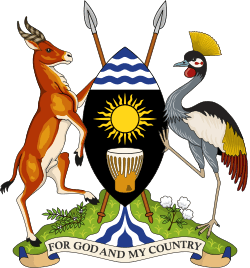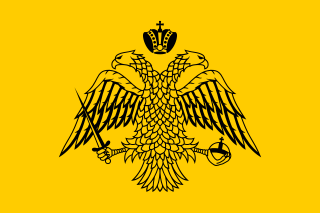Orthodox Christianity in Uganda
Uganda is the first country to the south of the Sahara where an Orthodox Christian community began to form.
Present day
Currently there are nine deaneries which are united into a metropolia headed by Metropolitan Jonah Lwanga. The headquarters is in Namungona, a neighborhood of the capital Kampala. The clergy consists of 48 priests and 7 deacons. It has 80 communities, some of which have no priests and are run by catechists. There are 41 brick and mortar churches, 17 medical clinics, and the Holy Cross Mission Hospital. Approximately 30,000 Ugandans claim Orthodox baptism, but far fewer actually attend services. Many parishes have boarding schools where children not only study, but live and eat at the expense of their parents or outside sponsors. Most of the teachers are not Orthodox. Orthodox students who have been sponsored through the church, usually leave to teach at non-Orthodox schools. At Monde there is the most developed Orthodox village. Father Antonios Mutyaba is the priest of that parish. At Monde there are a primary and secondary school, a hospital, a church of Saint Anthony the Great, and the first monastery in Uganda with two nuns. The eldest of the nuns, Anastasia, is one of the first four Orthodox nuns in Uganda's history. In 1995 a seminary was opened within the Metropolia which is attended by 15 people. The program is designed for three years of study, and new seminarians are admitted once every two years. There is little teaching, and when the seminary is in session, the students spend most of the day idle. The most pressing problem for the church is the corruption of the priests. In 2014, the communities in Gulu and Lira removed themselves from the authority of Metropolitan Jonah and petitioned the Patriarch of Alexandria to give them their own bishop.
The Orthodox Church of Russia also has a mission parish, the Annunciation Orthodox Church on Bukasa Island in Lake Victoria. The parish was founded in 1983, and now is under the spiritual Omophore of Metropolitan Hilarion of ROCOR. Father Christopher Walusimbi is the parish priest. He has taken care of orphans and operates an ambulance service and was instrumental in the establishment of a school and a medical clinic. Both the school and clinic were dedicated to Saint Panteleimon of Nicomedia, but the Ugandan government assumed control and secularized them. The clinic which was started by Fr. Gerasimos in 1983 was abandoned after his expulsion from Uganda in 1988, however the use of aid from the Japanese government finished the clinic. Fr. Christopher planned and built the stone church building which is topped by a multi-colored Russian onion dome.
History
The founders of Orthodoxy in Uganda were four men, one of them Obadia Basajjakitalo. His grandson is Jonah, present Metropolitan of Kampala and of all Uganda.
Metropolitan Jonah said: "Some of the Africans were thinking people. They read books on the history of Christianity and found out that Catholics and Protestants are in opposition to each other in the way unsuitable for true Christians. They began to study thoroughly the Bible hoping to find answers to their questions. Once, one of them, an Anglican follower Rebuen Mukasa, encountered in a dictionary the word 'Orthodoxy' and became interested in its meaning. It was called a 'true Church, Mother Church' there. He showed this to his friends and began to seek for further information on Orthodoxy".
This went on in the year 1919. They began to send letters all over the world with the questions on Orthodoxy. One came to a US citizen of African ancestry named George Alexander McGuire. He sent them some literature on his non-canonical "African Orthodox Church". Rebuen Mukasa and his friends then were finally convinced in setting up this religion in Africa. McGuire directed them to a Black Bishop named Daniel William Alexander who lived in South Africa. He came to Uganda and ordained them. Rebuen Mukasa became Father Spartas. But the bishop turned to be an Uniate. This was disclosed later by a Greek businessman.
The friends didn't stop their quest here. Father Spartas and his supporters found a priest from the Ecumenical Patriarchate of Constantinople who traveled through Africa and baptized and chrismated (anointed) Greek children. He came to Uganda and stayed for about 18 months teaching Father Spartas, Irenaeus Magimbi, Theodoros Nankyama and his friends in Orthodox Faith. It was in the beginning of the 1930s. He advised them to place themselves under the Orthodox Patriarchate of Alexandria in order to be in Canonical Communion. They sent many letters to Alexandria, but there was no answer. In the meantime they baptized people and opened many parishes moving mainly by foot or by bicycles. They gained many followers, but without outside help Father Spartas, and the God loving Orthodox Christians with him, could not manage alone. Eventually they voyaged by foot, by river, by sea, by land until they arrived in the Alexandrian Patriarchate, where they spent several years being taught what Holy Orthodoxy was, ultimately being ordained and sent back to Uganda.
Canonical Orthodoxy
But later in the year 1946 Orthodox communities of Uganda and Kenya were accepted to join the Patriarchal Throne in full canonical contact. In 1959 in Uganda was sent Bishop Nicolas, Metropolitan of Kampala and the entire East Africa. From 1959 the Patriarch of Alexandria began to assume spiritual direction for the Orthodox Churches of Africa.
By 1958 for better ruling of Orthodox communities in Eastern Africa the Irinopolis Metropolia was founded with the center in the Tanzania capital Dar es Salaam], which means "city of peace", in Greek, Irinopolis. The Bishop again ordained Father Spartas and his friends with the accordance to canons of the mother church.
Father Spartas and his friends began to create their church. First four of them converted their relatives to Orthodoxy, and spreading of the faith went further. Spartas understood that the Church is in need of educated people. He began teaching English language in the school founded by him which was officially private and belonged to the Church. The colonial authorities (Uganda received independence only in 1969), trying to secure its monopoly on education, issued a law directing to teach English only in state schools. That didn't stop Spartas and he was then sent to prison for 5 years.
From 1958, some young Ugandans were sent to Greece and other Orthodox countries, but few of them returned to the motherland. That became one of the problems. those who returned often conflicted with elder priests.
In 1959 Father Spartas visited Greece. He made speeches to Christians and called for Greeks to come to Africa for catechization and founding of a mission. It resulted in creation of several groups, mostly youth, of prayer and material support.
One of the priests in 1965, while being in the USA, addressed to 75 Greek parishes asking for help. Missionaries in Greece and the USA started to help African Orthodox followers, and still are helping them.
The first of the missionaries was Hieromonk Chrysostom Papasarantopulos, who came to Uganda in 1960. He served in Africa till his death in December 1972. One of the most prominent missionaries was Stavritsa Zachariou, an American woman of Greek ancestry who arrived in East Africa in 1971. She painted icons and taught Africans the basics of housekeeping.
The help of Greek missionaries was useful, but the principal affairs on apostolic sermon were held by native Africans themselves.
In 1972 in Alexandria for the first time in history three native Ugandans were consecrated Orthodox bishops. One of them was the enlightener of Uganda Spartas Rebuen Mukasa, named the bishop Christophor Nilopolian. He died in 1982 as the prelate of this church.
By this time they joined the Alexandria Patriarchy there were more than 10 thousand followers of Makasa and Basadjikitalo in Uganda. There is no statistics on this, and exact numbers can hardly be known. Some sources state that in the beginning of 90s there were more than 200 thousand, and in 2004 there were about 1.5 million of Orthodox Christians in Africa.
Starting from 1995, the first African became Metropolitan — the Metropolitan of Kampala and the entire Uganda Theodoros Nankyama. From 1997, he was followed by Jonah, grandson of Obadia Basadjikitalo.
See also
- Greek Orthodox Church of Alexandria
- Chrysostomos Papasarantopoulos
- Jonah (Lwanga) of Kampala
- George Alexander McGuire
- African Orthodox Church (non-canonical)
- Raphael Morgan
References
- The original article is based on a translated Russian article Православие в Уганде, where sources for the data are stated.
Further reading
- Metropolitan Makarios (Tillyrides). Adventures in the Unseen. Orthodox Research Institute, 2004. 548 pp. ISBN 978-0-9745618-5-1
- Metropolitan Makarios (Tillyrides). The Origin of Orthodoxy in East Africa. Orthodox Research Institute.


